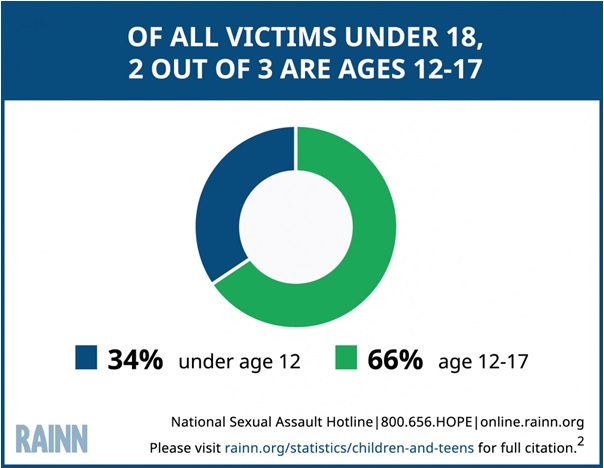10 Tips To Prevent Harassment And Create A Supportive School Environment
24th March 2023
Harassment in schools is a serious issue that needs to be addressed. It can take many forms, such as sexual, physical, emotional, or verbal abuse. No matter what form it takes, harassment can have a lasting impact on a student’s life.
According to rainn.org, students of age bracket 12-17 are the most gullible for sexual assault which is 66% and 34% of the children those who are under 12.

Source: rainn.org
As a teacher, you play a key role in preventing and addressing harassment in your school. You can do this by creating a safe and supportive environment where students feel comfortable talking about their experiences. You can also provide support and resources to students who have been harassed.
In addition, if you want to become a teacher who wants to understand their students psychologically and create a deep bond between them, then we do recommend our Certificate in Counselling Course for Teachers course, which will definitely help you to become an empathetic teacher and helps you to understand your students well.
Now without any delay let’s get to know 10 tips for talking to your students about harassment and prevent harassment in schools to create a safe environment for them:
Tip #1: Start the conversation early on
It’s important to start talking to your students about harassment early on in the school year, so they understand the boundaries and expectations around respect and behaviour. This conversation should begin in the first few days of school and should be revisited throughout the year. During this conversation, you can explain the different types of harassment that exist, such as verbal and physical, and how they can impact others. You can also explain the relevant laws and policies relating to harassment, so your students know the consequences of their actions.
Tip #2: Make it clear that harassment is not tolerated
It’s important to make it clear to your students that any form of harassment is not acceptable in your school. Make sure that your students know that any harassment – whether it’s physical, sexual, verbal, or emotional – will not be tolerated. You should also make it clear that the rules apply to everyone, including yourself. It’s important to emphasize that no one is exempt from the school’s anti-harassment policy so that all students understand that harassment won’t be tolerated.
Tip #3: Encourage students to speak up
It’s important to create an atmosphere to prevent harassment in schools where students feel comfortable speaking up if they or someone they know has been harassed. Let your students know that they can come to you with any problems they are having and that you will listen to them and take appropriate action. When appropriate, you can also encourage students to use their voices to help others in need. Explain that speaking up is a powerful way to stand up against harassment and create a more respectful environment for everyone.
Tip #4: Be a good role model
As a teacher, it’s important to model the behavior you expect your students to exhibit. Show your students through your own words and actions how to treat others with respect and kindness. You can demonstrate this by being mindful of the language you use, avoiding jokes that are derogatory or offensive, and intervening if you witness any form of harassment.
Tip #5: Promote inclusion and respect
It’s important to create an atmosphere of inclusion and respect in your classroom to prevent harassment in schools. You can do this by recognizing and celebrating diversity among your students and by discouraging any behaviour that is disrespectful or hurtful. You can also encourage your students to be open-minded and to show respect for the opinions of others.
Tip #6: Create a safe environment
It’s important to create a safe and supportive environment for your students, where they feel comfortable talking about any issues they’re facing to prevent harassment in schools further. This means that you should make sure that students have the opportunity to talk openly about their experiences without fear of being judged or punished. You should also avoid making assumptions about individual students and encourage them to feel comfortable expressing themselves without fear of repercussions.
Tip #7: Be open to different perspectives
It’s important to show that you are open to different perspectives and opinions. When discussing issues related to harassment, be sure to give your students the chance to speak and express their thoughts and feelings. While it’s important to make sure that your students understand and respect the boundaries of appropriate behaviour, it’s equally important to show them that their thoughts and feelings are valued and that they don’t need to be afraid of expressing themselves.
Tip #8: Help students understand power dynamics
Harassment often involves an imbalance of power, so it’s important to help your students understand power dynamics. Explain how different forms of power – such as physical, social, or economic – can be used to intimidate or exert control over another person. Demonstrate the importance of respecting power boundaries and ensure that students understand the consequences of their actions.
Tip #9: Encourage bystanders to take action
It’s important to empower your students to take action if they witness any form of harassment. Show them how to be an “upstander,” rather than a passive bystander, and explain the significance of intervening when needed. You can also provide resources and guidance on how to intervene safely and effectively, such as by speaking out or getting help from a trusted adult.
Tip #10: Follow up and follow through
Once you have had the initial conversation with your students about harassment, it’s important to continue to reinforce the message throughout the school year. Follow up by regularly reviewing the topic and providing resources and support to anyone who needs it. And make sure to follow through with any consequences that were outlined in the initial conversation.
Final Thoughts
Harassment is a real problem in schools and it’s important to take steps to prevent harassment in schools and address it when it does occur. As a teacher, you play a key role in creating an atmosphere of respect and safety in your classroom. By following these 10 tips, you can start a necessary conversation about harassment with your students and ensure that your school is a safe and inclusive environment for everyone.
In case. If you want to become a teacher who wants to understand their young learners well and help them to create a better future then we do recommend you to pursue our Certificate in Counselling Course for Teachers course, which will definitely be of greater help in your teaching journey.
Written By : Abhishek